
Meet The People Of The Canal - Take Our Silhouette Tour
Hodgkins
Robert Betz and Floyd Swink, Naturalists, Santa Fe Prairie
Santa Fe Prairie Preserve – 7300 River Rd.
Robert Betz and Floyd Swink have collaborated for decades to save and restore the remnants of Illinois’ once vast prairies. It all began here in 1959 when Swink, a leading authority on prairie plants, introduced Betz to the Santa Fe Prairie. Their dynamic leadership has inspired hundreds of volunteers and conservationists to preserve our remaining prairies.
Robert Betz – As a child in Chicago, Betz thought that vacant lots were prairies. At Santa Fe Prairie he learned what constituted a true prairie. Amazed by the variety of plants found here, Betz dedicated his work to the study of native prairies.
Floyd Swink – A dedicated educator, Swink also co-authored Plants of the Chicago Region, which catalogs native prairie plants in the area. His work has formed the basis for preserving Northeastern Illinois’ natural ecosystems.
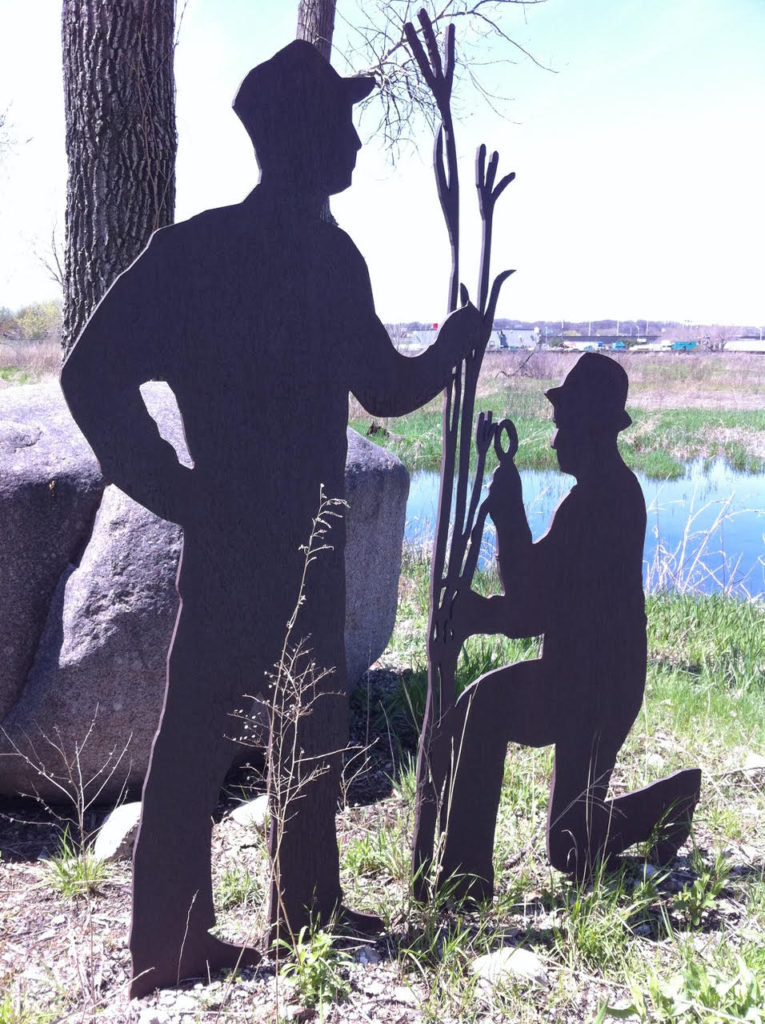
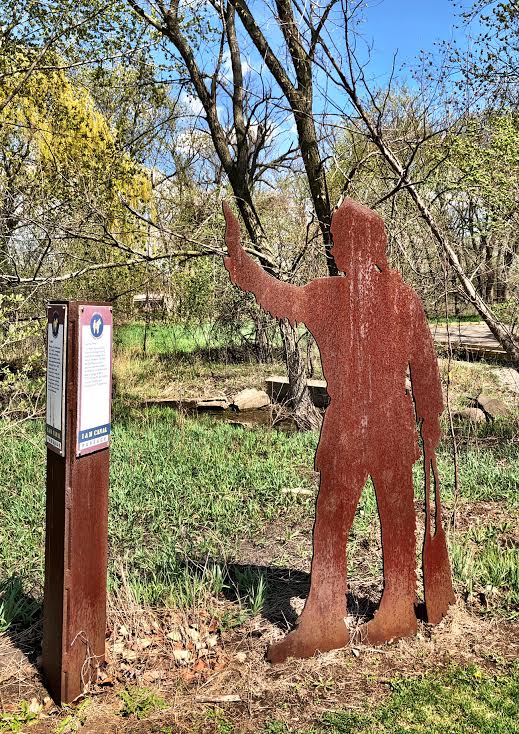
Romeoville
Pierre Moreau, Fur Trader, 1639-1727
Isle a la Cache Preserve/Museum – 501 E Romeo Rd.
Moreau, a fur trader known as “Le Mole,” accompanied Louis Jolliet and Father Jacques Marquette on their famous expedition down the Mississippi in 1673. Moreau stayed in the Chicago area to trade with Native Americans, and when Marquette was stranded in Chicago during the winter of 1674, Moreau sent him corn and blueberries.
“Le Mole” was said to be involved in illegal trading, aided by the expansionist French Governor. Moreau left the Illinois country and later moved to Quebec. He had 13 children and died at the age of 88 in 1727. He was the last known survivor of Jolliet and Marquette’s 1673 expedition.
Lockport
William Gooding, Canal Engineer, 1803-1878
On I&M Towpath in line with 9th St.
“…I have had nothing so much at heart as the good of the canal.”
Known for carrying his large field map with him when he was out inspecting construction, Chief Engineer for the I&M Canal William Gooding oversaw a remarkable engineering feat: the construction of a 96-mile canal through muddy, rocky, swampy and insect-infested terrain.
“The big canal is still progressing and now, ’tis known, is worth possessing.”
William Gooding lived and worked in Lockport, the headquarters of the I&M Canal. He designed a widewater and hydraulic basin that gave Lockport the waterpower to fuel its flour and paper mills and allowed it to become an important grain center. In his free time, Gooding was fond of writing poetry that described his thoughts and feelings.
Edward Retz , Mule Driver, 1826-1900
On I&M Towpath in line with 11th St.
Edward Retz came to the United States from Europe with $4.50 in his pocket (the equivalent of $175 today). His first job was as a mule driver on the I&M Canal. For ten or more hours each day, he drove a team of mules along the towpath as they pulled the 150-ton canal boats.


Joliet
Walter Olin, Steelworker & Bicycle Rider
Wheeler and Woods Sts.
Before people owned cars or had easy access to public transportation, they often had to walk long distances to work. In the 1920s, Walter Olin rode his bicycle to his job at the Joliet Iron Works. In the winter months, he put chains on his bicycle’s wheels, and bundled up in his warmest clothes for the long ride to the steel plant.
In the late 1800s, bicycles became a popular means of transportation in Joliet. Much like today, bicycle clubs planned social rides and races. By 1895, so many people were riding bicycles that the city passed an ordinance requiring the use of lamps on bicycles at night and established a speed limit of 6 miles per hour.
Peter Baum and John Stender, Quarry Workers
Billy Limacher Bicentennial Park – 201 W Jefferson St.
Hundreds of immigrants toiled in Joliet’s many quarries. The Irish were the first to come to Joliet. However, by the 1860s many laborers were German and many of those were young men in their twenties. Among them were John Stender and Peter Baum, both in their 20s.
For them, the work day lasted ten to twelve hours a day, six days a week for $1.50 a day. Most work was done by hand. Wedges were forced into joints and the stone was split away by repeated blows from hammers. Once the stone was cut from the quarry, it was broken into smaller blocks. Quarries were not open in the winter, so workers had to find other jobs during that season.
Patrick Smith, Irish Railroad Worker
Marion and Raynor Sts.
Irish immigrants first came here to dig the I&M Canal. By the 1870s, when Joliet was a railroad hub, many, like Patrick Smith, did the backbreaking work of laying tracks. Workers used picks, shovels and sledgehammers to clear the ground and drive in spikes. They worked long hours in the warmer months but often had to find other jobs in the winter.
As immigrants came to Joliet, they created their own ethnic communities, and churches were at the heart of them. In 1884, people worshipped in 21 different churches. St. Patrick’s and St. Mary’s served Irish families. Serbs went to St. George’s, Slovenians to St. Joseph’s, Germans to St. Peter’s and St. John’s and Croatians to St. Mary’s Nativity.
Harpo and Groucho Marx, Entertainers
Clinton and Chicago Sts. – Near the Rialto Square Theatre
The Marx Brothers, one the most famous comedy teams of the 20th century once owned a chicken farm near the I&M Canal. As far as farmers go, they were much better off as entertainers.
According to Groucho, they failed at farming because they spent too much time watching baseball at Wrigley Field and not enough minding the chickens. In the 1930s, the Marx Brothers performed at Joliet’s Rialto Square Theatre.
The Rialto Square Theatre was built by the six Rubens brothers who began planning it in the early 1920s. It was to be a “Palace for the people.” Joliet was at the peak of its industrial might when the theater opened in 1926. A few years later, during the Great Depression, entertainers brought smiles to those seeking to escape their economic worries.
Mary Setina, Candy Store Owner, 1873-1937
Slovenian Women’s Union and Heritage Museum – Clay and Chicago Sts
Mary Setina, a Slovenian immigrant, came to Joliet in 1903. She lived in the St. Joseph’s neighborhood, known as “Slovenian Row,” and owned a store there. Children on their way home from St. Joseph’s school stopped in the store, pennies in hand, to buy candy, ice cream or school supplies from her. Men going home from the mills bought tobacco at the store.
Joliet’s immigrant women often needed jobs to make ends meet. They were maids, seamstresses, washerwomen, cooks and shopkeepers. In addition to caring for their own families, many women took in boarders–such as workers from local steel mills and quarries–and had to cook, clean, wash, mend and iron for as many as a dozen men at a time.
George Kiser, Iron Works Laborer
Columbia and Scott Sts.
George Kiser, an African-American, moved to Joliet from Missouri in the early 1900s. A laborer at the Joliet Iron Works, he usually worked 12 hours a day in noisy, hot and dangerous conditions. The mill employed workers from all over the world. Immigrants from the south, like Kiser, were joined by Poles, Swedes, Germans, Bohemians and others.
Steel was one of Joliet’s major industries. The workers who flocked here for jobs found harsh conditions. Early mills were loud, dark and poorly ventilated, resulting in frequent accidents. Because of the conditions, men lost their hearing and developed lung disease from ore and steel dust. Blast furnace workers endured temperatures of 100-150 degrees and suffered heat stroke and exhaustion.
James Bruce, Quarry Owner, 1823-1898
Bluff and Jefferson Sts.
Born in Scotland, James Bruce learned about the local dolomite stone as an I&M Canal construction foreman. Canal workers had to blast through the stone and used it to build the canal’s locks and walls. Bruce later used that stone to make his fortune, opening quarries in Joliet and Lockport that employed hundreds of workers.
In the 1880s, Joliet area quarries employed thousands of men, mostly immigrants from Sweden, Poland, Italy, Germany and Czechoslovakia. Quarrying was hard work. Workers were paid only about $1.25 per day to pry and dig out the stone in pieces. To keep them from unionizing, quarry owners separated workers from different countries, so they wouldn’t form any relationships and lasting bonds.
Francis Hoffman, Mason
Billy Limacher Bicentennial Park – 201 W Jefferson St.
In 1860 Hoffmann worked as one of Joliet’s many stone masons. Stone masons took limestone from the nearby quarries and transformed it into magnificent buildings, many of which are still part of Joliet’s landscape.
Born in Holland, the forty-year-old Hoffmann first journeyed to Wisconsin before moving to Joliet. His wife Agnes, also born in Holland, gave birth to their four children here in the U. S.
Several churches constructed from Joliet stone still dominate the local skyline. St. Mary’s Carmelite Church and the Christ Episcopal Church are especially noteworthy. The latter is listed on the National Register of Historic Places. Joliet stone was also used in the Rock Island Arsenal, the old Chicago Water Tower and the Joliet Public Library. In addition, polished stone from Joliet was used for the interiors of the State Archives building in Springfield in 1938 and the Natural Resources Building in Urbana in 1940.
Lester Ward, Renaissance Man, 1841-1913
Billy Limacher Bicentennial Park – 201 W Jefferson St.
The last of ten children, Lester Frank Ward was born in Joliet at Joliet and Benton Streets. His father owned a quarry at what is now the site of the Illinois State Penitentiary, but Ward lived in Joliet only a short time. A true Renaissance Man, Ward was wounded in the Civil War and then earned degrees in law and medicine. But, he gained lasting fame as a paleontologist and sociologist.
Very few animals or plants become fossils as it takes just the right conditions for fossils to form. We are fortunate to have any evidence of ancient life, especially life that existed in the unimaginably distant past. Despite their tremendous age, these fossils are often remarkably well preserved. Molds of snails are found side by side with hundreds of brachiopod shells. However, fossils are rarely found completely intact, so look for partial specimens.
Sophia Demmond, Philanthropist, The Grand Old Lady of Joliet, 1804-1895
Billy Limacher Bicentennial Park – 201 W Jefferson St.
Sophia Murray married merchant Martin Demmond in New York in 1831, and they were among Joliet’s earliest residents when they arrived in 1834. The Demmond’s built Joliet’s first stone building from limestone quarried from the nearby bluffs. They lived on the 3rd floor and operated a general store on the first. During the winter of 1834-1835, less than fifty people lived in Joliet.
The Demmond’s were liberal supporters of educational efforts, and they helped fund the construction of the first school building in Joliet. Martin Demmond died in the cholera epidemic of 1854, and Sophia closed the store and became a generous donor to a variety of philanthropic causes. She also raised her niece Catherine, whose husband, Frederick Bartleson, died a hero in the Civil War. Sophia outlived her husband by 41 years, dying at the age of 91 in March 1895.
Morris
John Sullivan and Old Nell
Canalport Park – Griggs and Wauponsee Sts.
Old Nell of Morris was perhaps the most famous mule on the I&M Canal. For decades teams of mules pulled the 150-ton canal boats. Mule teams were changed every ten miles, and mule barns once dotted the landscape along the canal. Female mules were always the lead mule as they were considered smarter than the males. Nell became well known due to her ability to find her way home untended after her shift was over. Numerous mule and horse barns were located along the canal.
Many young men found jobs on the canal as canal drivers. In 1850 Morris had nineteen canal drivers, the majority of them teenagers. Massachusetts-born John Sullivan was the youngest, only fifteen-years-old. The drivers, like many in Illinois, were born elsewhere-three in Ireland, one in Canada and others from New York, Vermont, Ohio, Pennsylvania and Tennessee.
These “mule boys” had a reputation for swearing, drinking and fighting. Many had dogs to keep them company as they worked long, grueling shifts. Some lived in dormitories, such as the one that once occupied the top floor of the Norton Building in Lockport, Illinois.
The Armstrong Family
Canalport Plaza – Liberty and Illinois Sts.
“And eight I reared to manhood, and I brought to Illinois, a pleasant and a lively set of active little boys.”
In 1831 Elsie Armstrong, along with her sons, aged 3 to 19, arrived on the Illinois frontier, drawn by the promise of a new life away from her drunken husband in Ohio. Plans were underway to construct the Illinois and Michigan Canal.
Her sons soon helped build it. Three became founders of Morris–Armstrong Street bears their name. Elsie is buried nearby in Evergreen Cemetery.
“…How sweet the recollection, when my children were about me, then I felt I had protection, and no one dared to flout me.”
Elsie Armstrong wrote an epic poem that records the tragic deaths of four children. It expresses her pride in the sons who founded Morris and became community leaders. The poem is a rare record of a pioneer woman’s hardships, her feelings, and a poignant reminder of the importance of family.
Elsie Armstrong’s Sons
Canalport Plaza – Liberty and Illinois Sts.
William and George Armstrong were canal contractors who hired immigrant workers to hand-dig sections of the I&M Canal. William built Morris’ first courthouse and became sheriff.
Canal construction was financially risky. Many contractors, including William, went bankrupt. Tragically, he committed suicide in 1850. George served in the Illinois legislature and funded Morris’ first bridge over the Illinois River.
Elsie Armstrong’s sons illustrate the difficulties and possibilities of life on the frontier. Joel founded a bank. Jeremiah and Isaiah sought their fortunes in the California Gold Rush of 1849. Perry Armstrong ran a general store and later became a lawyer. He represented Morris in the Illinois legislature. Armstrong descendants still live in the canal corridor and have preserved the stories of Elsie Armstrong and her family.
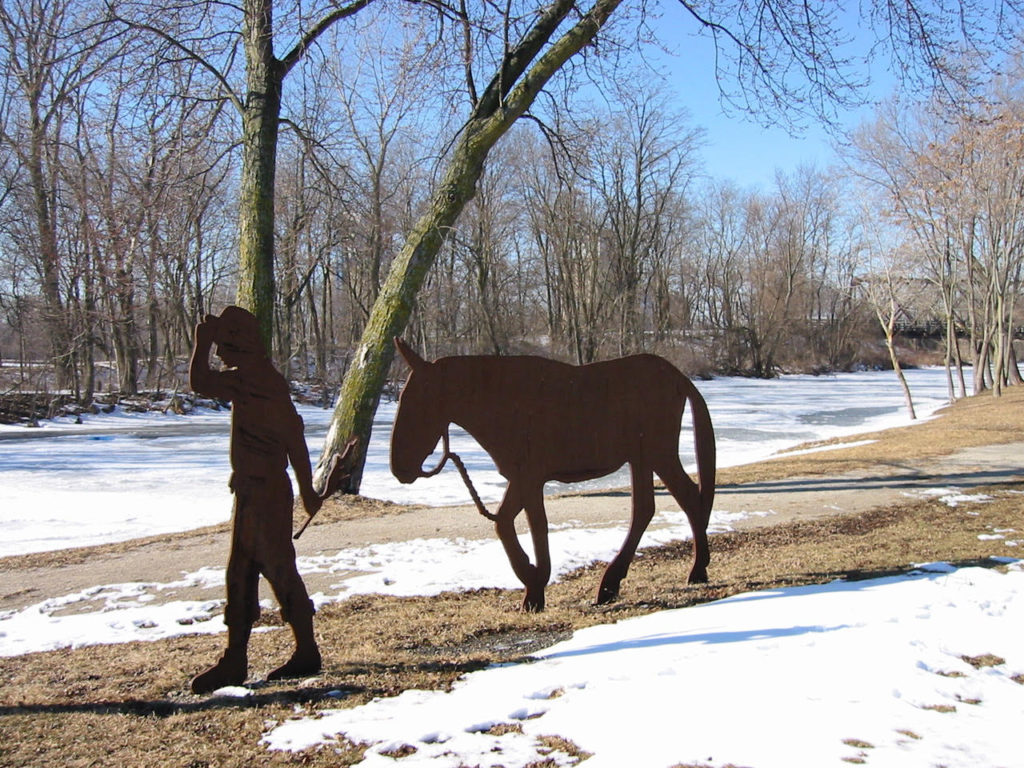
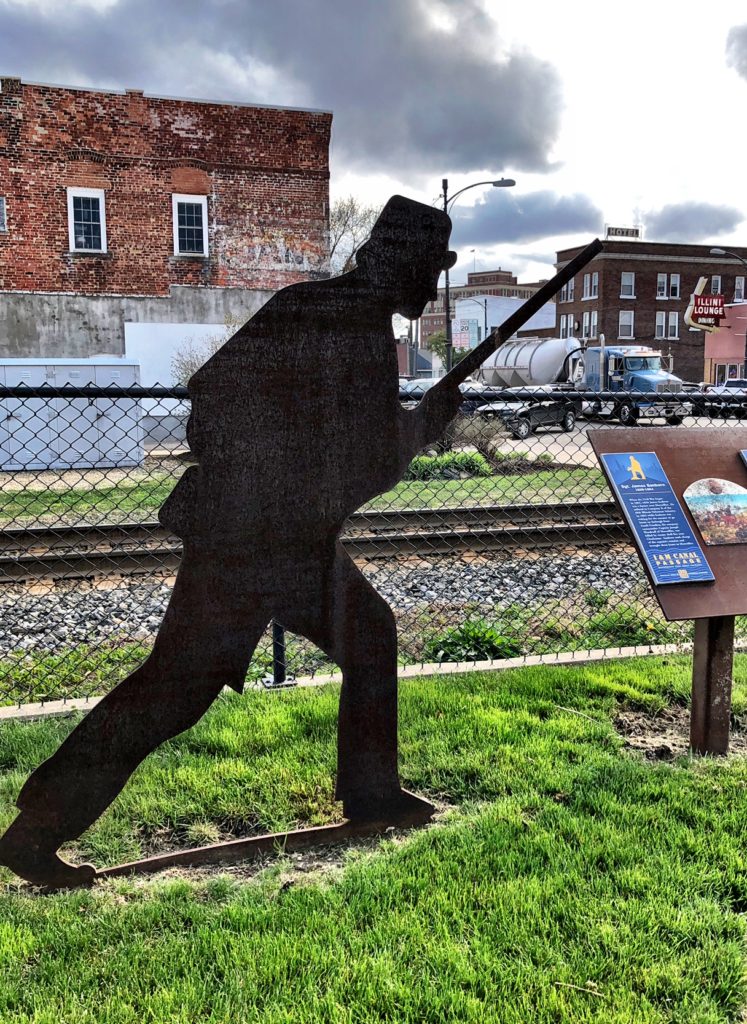
Marseilles
Sgt. James Sanborn, 1839-1864
Washington and Main Sts.
When the Civil War began in 1861, James Sanborn was a farmer near Marseilles. He enlisted in Company K of the 39th Illinois Volunteer Infantry. In 1863 while Sanborn was waiting for the steamer to go home on furlough from South Carolina, his company commander, Captain Joseph Woodruff of Marseilles, was killed by enemy shell fire near Charleston. Sanborn took charge of the captain’s remains and brought them home to Marseilles.
On August 16, 1864, at the Battle of Deep Run in Virginia, Sanborn was among 97 men and 7 officers of the 39th who lost their lives. His comrades were unable to recover his body. To this day he rests on that field among the “unknown.” Sanborn was one of over 250,000 Illinois men who served in the Union Army during the Civil War.
Utica
James Clark, 1811-1888
Canal and Mill Sts.
Born in England, engineer James Clark arrived in America in 1830, penniless. He found his way from New York to Ohio to Peoria and by 1835 he operated a stage coach line and was purchasing property locally. In 1837 he contracted to dig two miles of the I&M Canal. Owner of the Utica Hydraulic Cement Co., he built the nearby warehouse.
Clark’s influence and contributions to the development of Utica are legendary. He was Utica’s first postmaster, first assessor, supervisor, mayor, village president and State Representative. Also a businessman, he owned a sand business, was a grain purchaser and supplier and owned Utica’s first hotel.
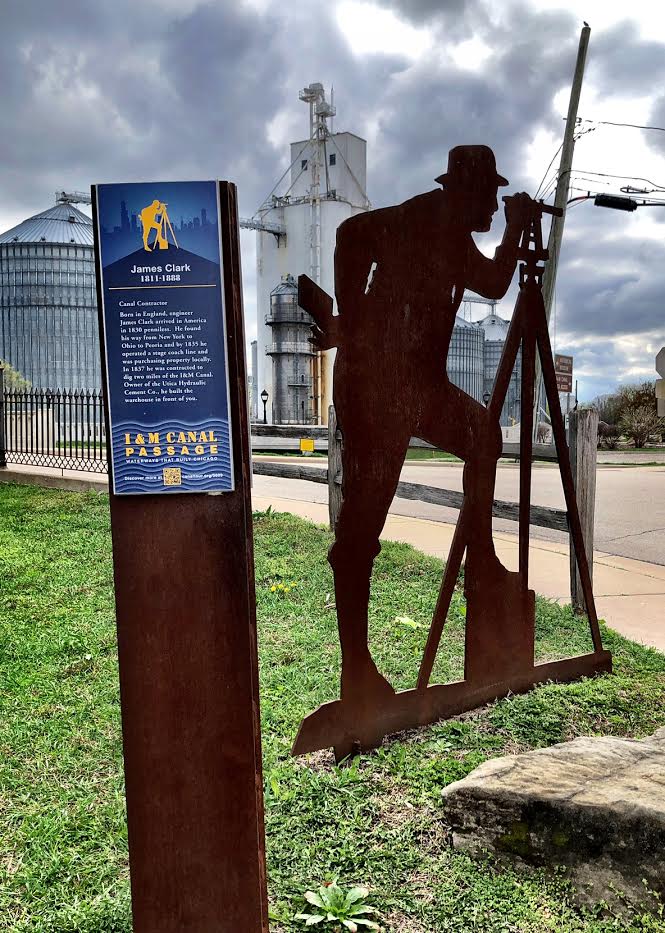
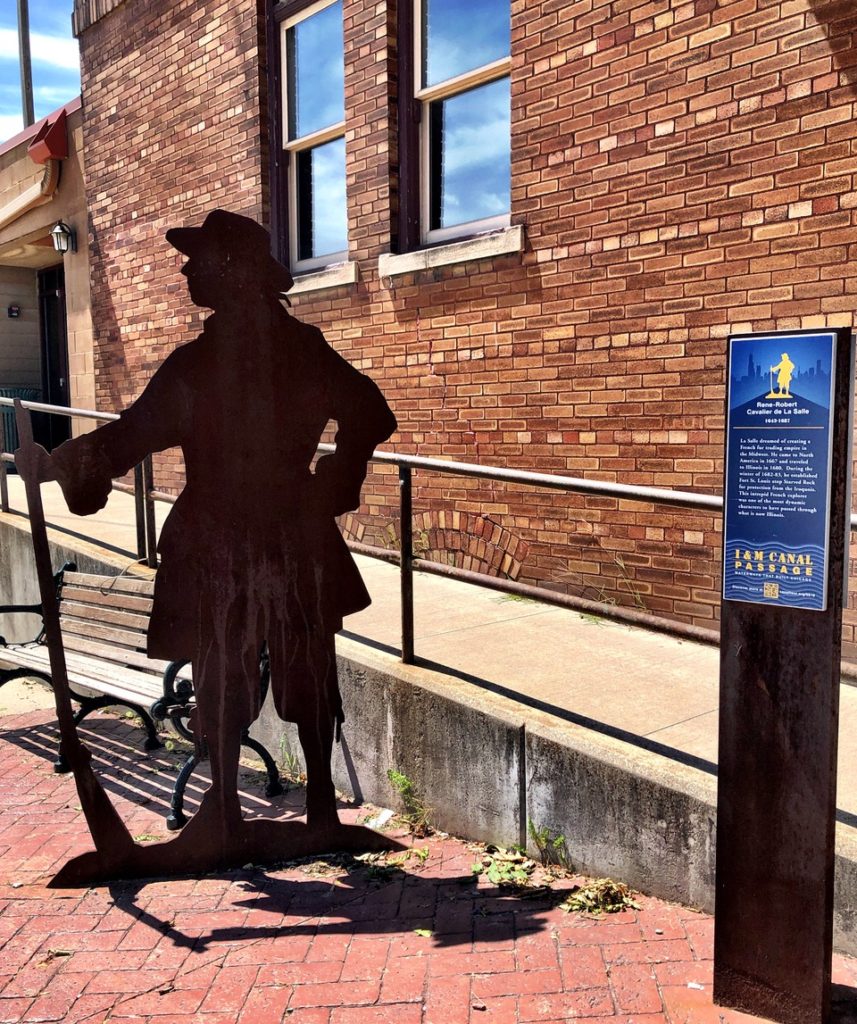
LaSalle
Rene-Robert Cavalier de La Salle, Explorer, 1643-1687
I&M Canal Visitor Center – 754 First Street
La Salle dreamed of creating a French fur trading empire in the Midwest. He came to North America in 1667 and traveled to Illinois in 1680. During the winter of 1682-83 he established Fort St. Louis atop Starved Rock for protection from the Iroquois. This intrepid French explorer was one of the most dynamic characters to have passed through what is now Illinois.
La Salle was most famous for his voyage of exploration down the Mississippi River to the Gulf of Mexico in 1681-82. He claimed all of these lands, later known as the Louisiana Territory, for France. For the two years before his death he fruitlessly searched for the mouth of the Mississippi River from the Gulf of Mexico. He was killed by one of his own men in what is now Texas.
John W. Connett, Boat Captain, 1812-1885
I&M Canal Lock 14 – Canal Rd &, IL-351
John Connett was one of the most popular packet boat captains on the I&M Canal. Born in western New York, he piloted a boat on the Erie Canal before moving to Chicago in 1848. One testimonial to Connett characterized him as “one of the most experienced and successful navigators on the canal and his affableness and accommodating manners, make passengers, while on board, feel that they are in comfortable quarters.” An attentive boat captain could make an uncomfortable passage more tolerable for harried passengers.
On one of his last trips on the I&M, Connett’s boat the Prairie Queen struck ice and sank in the canal. After the railroads took away the canal’s passenger trade in 1853, Connett quickly found work as an agent for the Michigan Central Railroad.
John Means, Locktender
I&M Canal Lock 14 – Canal Rd & IL-351
American canals developed a distinctive canal culture and society that included boat captains and crew, mule drivers and locktenders. Relatively little is known about the working class men who labored to keep the boats moving through the locks. Locktenders were paid $300 per year and were on call 24 hours a day from April until December. Their slumber was often interrupted by the bleating of the boatman’s horn, announcing a boat that needed to be locked through.
John Means was one of thousands who helped dig the I&M Canal, and in 1848 he was rewarded for his service by being appointed one of the original group of 13 locktenders on the I&M Canal. He manned locks 14 and 15 in LaSalle. During peak periods Means was constantly employed in opening and closing the massive lock gates. The lock gates were operated manually, and often the tender’s entire family was involved in the process of locking boats through. Passengers often disembarked during the tedious process of letting the water enter the lock, so a tender’s wife and children sold fresh fruit or other edibles to passengers.
Wild Bill Hickok, Mule Driver, 1837-1876
I&M Canal Lock 14 – Canal Rd & IL-351
The most famous mule driver on the I&M Canal was James Butler (Wild Bill) Hickok. In the first recorded fight of his long career, Bill tangled with a fellow canal driver who had been abusing his mules. Incensed at this cruel treatment of animals, Bill tangled with Charles Hudson and both men tumbled into the canal. Bill eventually headed west where he gained fame as a lawman and gunslinger. He scouted for Custer and met personalities like Calamity Jane and Buffalo Bill Cody. At the age of 39 he was bushwacked and killed in Deadwood, South Dakota.
Drivers were responsible for leading the mules or horses that pulled the boats along the canal towpath. They often walked 10-15 miles per day and also helped care for the mules. Canal drivers had to coax stubborn mules and occasionally attempt to rescue horses or mules that fell into the canal. Drivers were also responsible for noting breaches in the towpath, and they coordinated the sometimes-tricky maneuver when boats passed each other. A number of drivers drowned in the canal attempting to save mules or horses that had fallen in. The majority of drivers were boys or young men, although some were as old as thirty.
Abraham Lincoln and Family, Canal Passengers and Supporters, 1809-1865
I&M Canal Lock 14 – Canal Rd & IL-351
In the mid 1830s Abraham Lincoln, then a member of the Illinois State Legislature, voted in favor of construction of the I&M Canal. A staunch advocate of public works projects, Lincoln knew that the young state of Illinois desperately needed to improve its transportation system. As a member of the U. S. House of Representatives, Lincoln trumpeted the positive effects of the I&M Canal in the nation’s capitol.
While acknowledging that the I&M Canal was entirely within the confines of one state, he noted that its benefits extended far beyond those borders, reducing the cost of transporting goods thus benefiting both buyers and sellers. “Nothing is so local as not to be of some general benefit,” wrote the future President. “The benefits of an improvement are by no means confined to the particular locality of the improvement itself.”
During the canal’s opening year of 1848, Lincoln, his wife Mary and their two children Robert and Edward (ages 5 and 2, respectively) took a ride from Chicago to LaSalle on a canal packet. From here they transferred to a steamboat bound for Peoria where they disembarked and boarded a stagecoach for the final leg of their trip to Springfield.
Chief Shabbona, Native American Chief, 1775?-1859
I&M Canal Lock 14 – Canal Rd & IL-351
A muscular bear of a man, Shabbona was born a member of the Ottawa tribe but became a Potawatomi chief when he married a woman from that tribe. During the War of 1812 Shabbona fought with the British against the Americans, but he later became friends with early Illinois settlers. In 1832 Shabbona opposed Black Hawk’s War and warned white settlers in advance of attacks. After the war most Indians in Illinois were forced to settle west of the Mississippi River. Shabbona, however, was given a large tract of land in DeKalb County. Returning home after a long absence from a visit to his tribe, he found that his land had been stolen. Fortunately, sympathetic friends bought him a plot of land near Seneca. He died at the age of 84 in 1859 and is buried in Evergreen Cemetery in Morris.
Imagine Chief Shabbona’s astonishment on a visit to Chicago in the summer of 1852. Visiting with his old friend John H. Kinzie, the collector of I&M Canal tolls at Bridgeport, Shabbona stood in “wonder and admiration” at the remarkable changes that had taken place in sixteen years. In a few years Chicago had risen from a tiny military outpost to a thriving city of nearly 40,000.
Clara & Olivia Matteson – Canal Passengers
I&M Canal Lock 14 – Canal Rd & IL-351
Sarah Norris took a 22-hour trip from LaSalle to Chicago after which she said “I can’t tell you how pleased I was to leave the canal boat, a little, low, crowded place, moving along at a snail’s pace in comparison with steamboats.” Emily Chandler took a packet from LaSalle to Chicago in September 1851, writing her sister that the trip was “a thing which I cannot describe, though not very pleasant at night when crowded.” Traveling with her older sister Olivia, Clara Matteson, the nine year old daughter of Illinois Governor Joel Matteson, exclaimed that the voyage was ” so crude that I cannot understand how people submitted to it.”
While canal packets moved slowly compared to river steamboats, many enjoyed traveling via the canal. As one commentator on an eastern canal wrote, “To the lover of nature, the canal is an ideal method of travel. Rocks and trees, birds and flowers on the shore can be studied leisurely in detail, and every landscape is indelibly photographed on the memory as it slowly vanishes in the distance.” Some preferred the canal over the railroads, as, “there was no danger of collision, of misplaced switch, of scalding steam, of crushing timbers, or any other dreadful disaster.”
Gurdon S. Hubbard, Canal Commissioner, 1802-1886
I&M Canal Lock 14 – Canal Rd & IL-351
Over the course of his long and eventful life Gurdon Hubbard helped transform Chicago from an uninhabited swamp into the fastest growing city in the US. He first came to Illinois as a fur trader in 1818, and Native Americans dubbed him Swift Walker. “He wore a buckskin shirt and carried a knife and tomahawk. . . and let his hair grow long.” With the close of the fur trade Hubbard made Chicago his permanent home in 1834. He served as one of the original I&M Canal Commissioners speaking at the groundbreaking in July 1836.
Hubbard became a business tycoon, dabbling in meatpacking, real estate and insurance. With financial interests in various places along the canal, including nearby Utica, Hubbard was among the first to see the entire canal corridor as a cohesive business unit. The Great Chicago Fire of 1871 bankrupted him, but his life spanned an epoch in Chicago’s history–from the fur trade to the rise of a major city in the American heartland.
Father John O’Reilly, Missionary, 1802-1862
I&M Canal Lock 14 – Canal Rd &, IL-351,
Catholicism came to LaSalle in 1838 when missionaries were sent here to serve the spiritual needs of hundreds of young Irish canal diggers. Within weeks the two priests had to face a devastating epidemic and labor violence on the canal. Despondent, one of them wrote his superiors that he would rather be sent west with the Indians than stay in LaSalle. Father John O’Reilly arrived in LaSalle in October 1848 and quickly became a beloved figure among the large Irish population. Talented and energetic, O’Reilly was a compelling speaker who ministered wisely to his flock and encouraged further Irish immigration to America.
O’Reilly had his hands full in wide open LaSalle, known for its many saloons. A friend described O’Reilly as a “champion of the oppressed, a disciplinarian, a sworn enemy to rowdyism, which he fought with forcible and scathing invectives, irrespective of creed, and did his best to cleanse the town of such questionable element.” During his nearly ten years in LaSalle, O’Reilly broke up countless barroom fights, but he also helped to raise the morals and manners of its citizens.
Grenville M. Dodge, Canal Passenger & Union General, 1831-1916
I&M Canal Lock 14 – Canal Rd & IL-351
Grenville M. Dodge is perhaps the most famous person to record his I&M Canal packet boat experience. He later gained fame as a Union General in the Civil War and as chief engineer of the transcontinental railroad. His account gives some idea of the rough and tumble nature of many canal towns in the 1850s. “There was a curious crowd aboard this packet and, as we passed through Joliet, nearly all the passengers were up on deck shooting at the bull snakes that lay on the shelving rocks through which the canal had been cut. The shooting was very bad; it was very seldom they hit a snake. Being a pretty good shot myself, I thought I would try my hand and went down into the cabin and got my pistol. At the first shot I laid out a snake and that fixed my reputation on that boat from there to LaSalle.”
Dodge soon experienced the rough and tumble nature of canal towns. “When I got off the boat I found that Peru, the place I was destined for, was a mile away. I stepped up to Captain Wheeler to ask him how I could get there. He was talking excitedly to a man when another man stepped up and shot the man who was talking to Capt. Wheeler. It did not seem to create much excitement.”